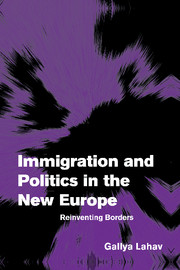Book contents
- Frontmatter
- Contents
- List of figures and tables
- Preface and acknowledgments
- 1 Introduction
- 2 Toward a people's Europe: an institutional analysis of immigration policy in the European Union
- 3 An attitudinal portrait of a people's Europe: a comparative overview of public opinion and elite preferences
- 4 Immigration politics and the new Europe: organizing competing interests
- 5 The “European factor”: institutional and psychological constraints on immigration attitudes
- 6 Conclusions: the construction of a European immigration regime?
- Appendices
- Bibliography
- Index
5 - The “European factor”: institutional and psychological constraints on immigration attitudes
Published online by Cambridge University Press: 18 December 2009
- Frontmatter
- Contents
- List of figures and tables
- Preface and acknowledgments
- 1 Introduction
- 2 Toward a people's Europe: an institutional analysis of immigration policy in the European Union
- 3 An attitudinal portrait of a people's Europe: a comparative overview of public opinion and elite preferences
- 4 Immigration politics and the new Europe: organizing competing interests
- 5 The “European factor”: institutional and psychological constraints on immigration attitudes
- 6 Conclusions: the construction of a European immigration regime?
- Appendices
- Bibliography
- Index
Summary
Act V, Scene 1: In his affluent home in the suburbs of London, one of the most pro-European Tories of the European Parliament reflected on the contentious fate of Europe. “Let's just take a bird's eye view of the political landscape of Europe, when it comes to reaction to the EC. The Maastricht Treaty in the last few months has triggered a nationalist response in most of the member-states – not all, but most of them. That backlash has to do with a perception of the national identity – that the national culture is being threatened by things foreign. It is often not more specific than that. There is this feeling of minority cultures being swamped by something terrible. And this something terrible is linked to Europe, because the feeling is that all of a sudden there is too much Europe happening.”
(Diary of researcher, based on interview no. 44, London, April 22, 1992.)Although traditional partisan/ideological and national interests continue to inform issue attitudes in Europe, the elusive organization of political cleavages in the immigration debate compels us to examine the changing “playing field.” While the analysis in chapter 4 underscored the relevance of domestic constraints on immigration thinking, it suggests that there is some attitudinal convergence that may be related to regional integration. The emergence and consolidation of some type of transnational Europe merit consideration for their effects on policy motives and preferences.
- Type
- Chapter
- Information
- Immigration and Politics in the New EuropeReinventing Borders, pp. 149 - 203Publisher: Cambridge University PressPrint publication year: 2004

